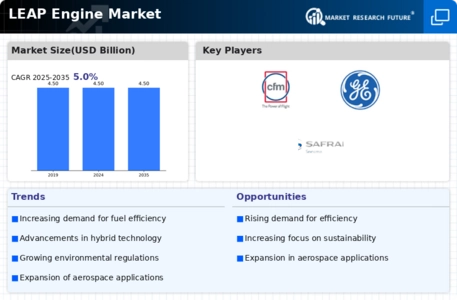Leap Engine Size
LEAP Engine Market Growth Projections and Opportunities
The Leap Engine market is witnessing substantial growth, driven by a confluence of market factors that underscore the demand for efficient and advanced propulsion systems in the aviation industry. A significant driver of the Leap Engine market is the global surge in air travel and the increasing demand for fuel-efficient aircraft. Airlines and aircraft manufacturers are prioritizing fuel efficiency to reduce operational costs and environmental impact. The Leap Engine, developed by CFM International, a joint venture between GE Aviation and Safran Aircraft Engines, is at the forefront of meeting these demands with its innovative design and cutting-edge technology, making it a preferred choice for next-generation narrow-body aircraft.
Technological advancements are pivotal in shaping the Leap Engine market. The Leap Engine incorporates state-of-the-art features, including advanced materials, 3D aerodynamics, and a unique composite fan design. These innovations contribute to higher fuel efficiency, reduced emissions, and overall improved performance. The incorporation of advanced technologies positions the Leap Engine as a competitive and reliable choice for aircraft manufacturers looking to meet stringent environmental regulations and address the growing emphasis on sustainability in aviation.
The Leap Engine market is significantly influenced by the trend towards fleet modernization and the introduction of new-generation aircraft. Airlines globally are retiring older, less fuel-efficient aircraft in favor of new, more technologically advanced models. As a result, the demand for modern engines, such as the Leap Engine, has seen a notable uptick. Aircraft manufacturers, recognizing the need for propulsion systems that align with the latest industry standards, are increasingly opting for the Leap Engine to power their new aircraft models.
Regulatory factors play a crucial role in shaping the Leap Engine market, with stringent emissions and noise regulations driving the development and adoption of more environmentally friendly engines. The Leap Engine's compliance with international aviation standards positions it favorably in a regulatory landscape that prioritizes cleaner and quieter aviation technologies. Meeting these standards not only ensures market acceptance but also establishes the Leap Engine as a key player in addressing the global aviation industry's commitment to sustainability.
Global economic factors and airline operational considerations contribute to the dynamics of the Leap Engine market. Economic growth, especially in emerging markets, leads to increased air travel demand, prompting airlines to expand and modernize their fleets. As airlines seek to enhance operational efficiency and reduce operating costs, the fuel efficiency and reliability offered by the Leap Engine become crucial factors influencing purchasing decisions.
The competitive landscape of the aviation industry, including the rivalry between major engine manufacturers, is another factor shaping the Leap Engine market. CFM International faces competition from other engine manufacturers, each vying for a share of the market. Innovations, performance, and cost-effectiveness are key differentiators in this competitive environment, with the Leap Engine's technological advancements positioning it as a frontrunner in the race for market share.
The aftermarket segment also plays a role in the Leap Engine market, with maintenance, repair, and overhaul (MRO) services becoming increasingly important. Airlines, seeking to optimize the performance and lifespan of their fleets, rely on MRO providers for engine maintenance. The availability of a robust aftermarket support network enhances the appeal of the Leap Engine, contributing to its sustained market growth.







Leave a Comment